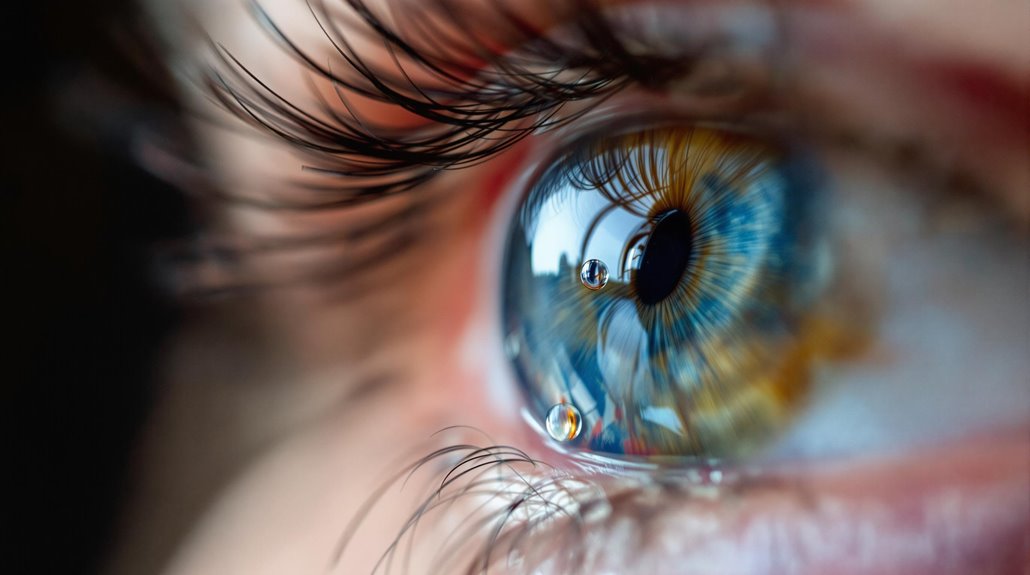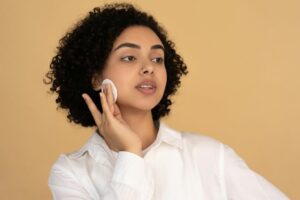I’d bet you didn’t know that different types of eye drops can take anywhere from one minute to several weeks to work effectively. As someone who’s studied ocular medications extensively, I can tell you that timing isn’t just about the drops themselves – it’s about your specific condition, the drop’s ingredients, and even how you apply them. Understanding these essential factors will help you get the most from your eye medication and avoid common mistakes that could delay relief.
Different Types of Eye Drops and Their Response Times

When it comes to understanding how quickly eye drops will work, I’ve found that different types are designed to provide relief at varying speeds based on their specific purpose.
I want you to know that over-the-counter drops for dry eyes typically start working within minutes, while allergy relief drops may take 15-30 minutes to reach full effectiveness.
For prescription drops, the timing varies considerably based on what they’re treating.
If you’re using antibiotic drops, you might notice improvement within 24 hours, though you’ll need to complete the full course.
Glaucoma drops often take several weeks to achieve optimal pressure reduction, while steroid drops for inflammation usually begin working within a few hours.
I always recommend following your doctor’s specific instructions for timing and frequency.
Understanding the Science Behind Eye Drop Absorption
Since eye drops interact directly with your eye’s complex layers, I want to explain how they’re actually absorbed into the tissue.
Different absorption mechanisms work depending on where the medicine needs to go – through the cornea, conjunctiva, or deeper eye structures.
When you place drops in your eye, they first mix with your natural tears. The eye drop formulations are specifically designed to match your tears’ pH and consistency for ideal absorption.
I find it fascinating that your eye can actually absorb medicine through several routes: through the cornea’s surface cells, between those cells, or through specialized channels.
Your blinking helps spread the drops across your eye’s surface, but it also means some medication washes away.
That’s why it’s important to keep your eyes closed for about two minutes after applying drops.
Factors That Impact Eye Drop Effectiveness
The effectiveness of your eye drops depends on several key factors that I regularly discuss with my patients. Proper application technique, including keeping your eyes closed for 1-2 minutes after use, can remarkably improve absorption.
I’ve found that timing also matters – some eye conditions respond better when drops are used at specific times of day.
Your overall eye health, the severity of your condition, and whether you’re using other medications can influence how quickly drops work.
Additionally, dosage variations play a vital role – using too much or too little can affect the treatment’s success.
I always remind my patients that environmental factors like air quality and screen time can impact how well their drops perform, while proper storage of the medication guarantees it maintains its potency.
Time Frames for Common Eye Drop Categories

Different types of eye drops require varying amounts of time to start working, which I’ll outline based on my years of experience treating patients.
For lubricating drops that relieve dryness, you’ll notice relief within 1-2 minutes. Allergy eye drops typically take 10-15 minutes to reduce itching and redness, while decongestant drops work in about 5-10 minutes.
If you’re using antibiotic drops for infection, expect initial comfort within 30 minutes, though full effectiveness takes several days of consistent use.
For dilating drops used during eye exams, I’ve found they take 15-30 minutes to fully expand your pupils.
Glaucoma drops vary considerably – some pressure-reducing effects begin within 2 hours, while others need several weeks for ideal results.
Best Practices for Eye Drop Application and Timing
While applying eye drops may seem straightforward, proper technique guarantees you’ll get the maximum benefit from your medication and avoid wasting expensive drops. Let me share some key application techniques that’ll help guarantee dosage accuracy and best results.
| Step | Best Practice |
|---|---|
| Prep | Wash hands thoroughly and check drop expiration |
| Position | Tilt head back, look up at ceiling |
| Technique | Pull lower lid down to form pocket |
| Placement | Hold dropper close but don’t touch eye |
| After | Keep eyes closed 1-2 minutes, compress tear duct |
I recommend waiting at least 5 minutes between different types of drops if you’re using multiple medications. This prevents one medication from washing away another and guarantees proper absorption of each drop into your eye.
Signs That Your Eye Drops Are Working
Several clear indicators can help you determine if your eye drops are working effectively, though the timing and signs may vary depending on the specific type you’re using.
I want you to know that paying attention to your body’s response is essential for ensuring proper treatment.
- You should notice a gradual reduction in your initial symptoms, like redness, itching, or dryness, within the timeframe your doctor specified for symptom relief.
- Your vision may become clearer and more focused, especially if you’re using drops for conditions like glaucoma or allergies that affect vision improvement.
- Physical discomfort around your eyes should diminish, including any burning sensation, feeling of pressure, or general irritation that prompted you to use the drops.
If you don’t experience these positive changes, I recommend contacting your eye care provider.







